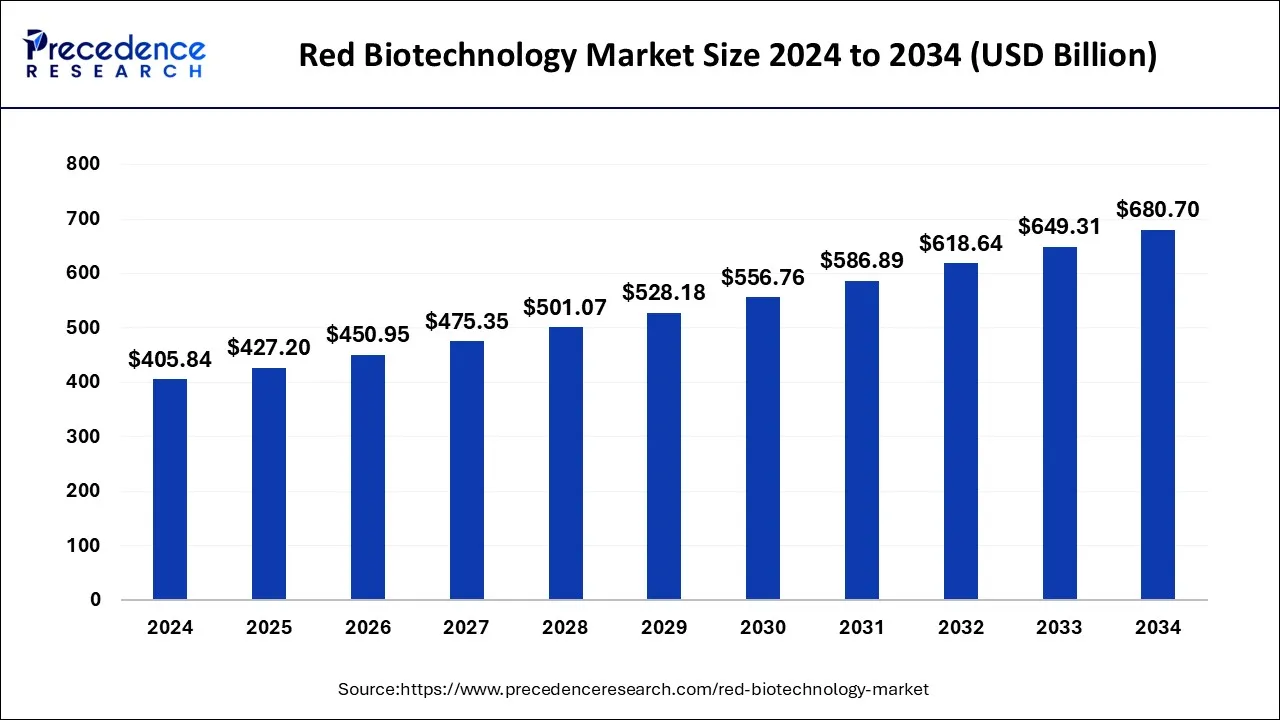The red biotechnology market was valued at USD 385.01 Bn in 2023 and is projected to skyrocket to USD 649.31 Bn by 2033, growing at an impressive CAGR of 5.36%.
Key Takeaways
- North America accounted for the largest market share of over 38.17% in 2023.
- Monoclonal antibodies dominated the product segment in revenue share for 2023.
- Pharmaceutical and biotechnology companies contributed 46% to the revenue share in 2023.
- The CMOs & CROs segment is projected to grow at an impressive CAGR of 12.9% between 2024 and 2033.
The biotechnology market is growing rapidly, as breakthroughs in medical therapies, diagnostics, and treatments gain momentum. This market deals with the development of new healthcare solutions for crucial health problems such as genetic disorders, cancer, and infectious diseases. It is a highly advanced field of innovation, involving the use of cutting-edge technologies like monoclonal antibodies, gene therapy, and personalized medicine. With more investment in pharmaceutical and biotechnology, the market will grow considerably. With ongoing technological advancement in the process, red biotechnology markets hold enormous potential for revolutionizing healthcare and bringing in new opportunities in relation to enhanced patient outcomes and transformative solutions.
Sample Link: https://www.precedenceresearch.com/sample/1010
Market Scope
| Report Highlights | Details |
| Market Size in 2023 | USD 385.01 Billion |
| Market Size by 2033 | USD 649.31 Billion |
| Growth Rate from 2024 to 2033 | CAGR of 5.36% |
| Largest Market | North America |
| Fastest Growing Market | Asia Pacific |
| Base Year | 2023 |
| Forecast Period | 2024 to 2033 |
| Segments Covered | Product Type, Application, End User, Region |
Key Drivers
Advanced developments in gene therapy, monoclonal antibodies, and cell-based treatments are highly accelerating the signs of progress. Increased Research and Development by companies, healthy government policies along the fast-aging demographics of the whole world are facilitating the growth momentum of the Red Biotechnology industry. Higher expenditures on healthcare in addition to emphasizing personalized medicine give new opportunities for expansion as well as innovation opportunities for the sectors.
Opportunities
- The red biotechnology market is expanding rapidly, driven by advancements in gene therapy, regenerative medicine, and biologics.
- Valued at USD 385.01 billion in 2023, it is projected to reach USD 649.31 billion by 2033, with a CAGR of 5.36%.
- North America held the largest market share in 2023, accounting for over 38%, with the U.S. expected to grow at a CAGR of 5.37% by 2033.
- Europe is witnessing strong growth due to increased research activities and the expansion of healthcare infrastructure.
- Asia Pacific offers significant opportunities, fueled by product approvals, growing CMO and CRO operations, and rising investments in biopharmaceuticals.
- The biopharmaceutical sector is expected to dominate the market, driven by increasing demand for biologics and a rise in clinical trial activities.
Challenges
- High R&D Expenses: Developing red biotechnology products requires substantial financial investments, which can be particularly challenging for small and medium-sized enterprises.
- Regulatory Challenges: The intricate and stringent approval processes for clinical trials and commercialization often lead to delays and higher costs, creating barriers to market entry.
- Ethical Dilemmas: Controversies surrounding gene editing, stem cell research, and the use of human tissues can spark ethical debates, potentially restricting market advancements.
- Extended Development Cycles: The lengthy timeline from research to regulatory approval for red biotechnology products delays market availability and return on investment.
- Rising Competition: The growing presence of biosimilars and generic alternatives poses significant competition, impacting the adoption of innovative therapies.
- Supply Chain Constraints: Maintaining a reliable supply of high-quality raw materials and ensuring consistent standards for biologics remain pressing challenges, particularly in developing markets.
Regional Insights
Red Biotechnology Market regional variation is also significant. Advanced healthcare infrastructure with strong R&D investments and favourable regulations, most notably in the U.S. drive North American success. Europe progresses steadily, primarily due to governmental support for innovation in biotech and strong pharma industries as in Germany or the UK. Asia-Pacific also gains momentum: China and India are leading factors, with strong biotech investment, cost-effectiveness in manufacturing, and extended healthcare systems. Latin America and the Middle East, though growing and with a much greater emphasis placed on healthcare and biotechnology, still pose various challenges, including regulation and infrastructure limitations.
Don’t Miss Out: Steam Turbine Market
Market Key Players
- Hoffmann-La Roche, Ltd.
- Merck KGaA
- Regeneron Pharmaceuticals, Inc.
- Pfizer, Inc.
- Biogen Inc.
- Amgen Inc.
Recent News
The red biotechnology market is expected to reach USD 649.31 billion by 2033, with a CAGR of 5.36%. North America is still the market leader, but Asia Pacific is fast becoming the fastest-growing region. Monoclonal antibodies and recombinant proteins are among the major growth drivers, with increased R&D investments. The biopharmaceutical sector is the largest market share, with continuous advancements in medical treatments that are driving overall market growth.
Market Segmentation
By Product Type
- Monoclonal Antibodies
- Polyclonal Antibodies
- Recombinant
- Proteins Vaccines
- Cell-Based Immunotherapy Products
- Gene Therapy Products
- Cell Therapy Products
- Tissue-Engineered Products
- Stem Cells
- Cell Culture
- Viral Vector
- Enzymes
- Kits and Reagents
- Animal models
- Molecular diagnostics
- Others
By Application
- Pharmacogenomics
- Biopharmaceutical Production
- Gene Therapy
- Genetic Testing
By End-user
- Research Institutes
- CMOs & CROs
- Biopharmaceutical Industries
- Others.

